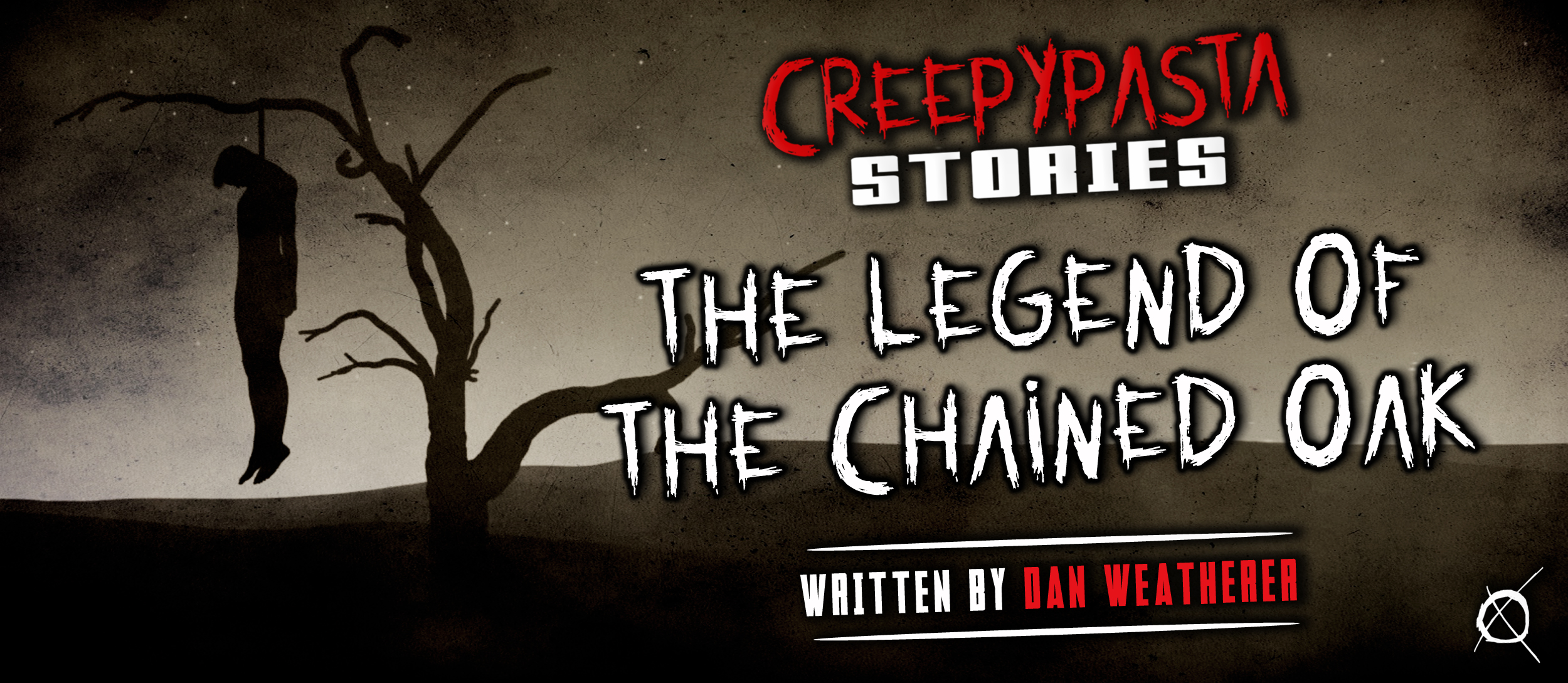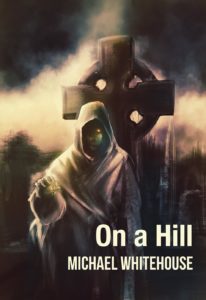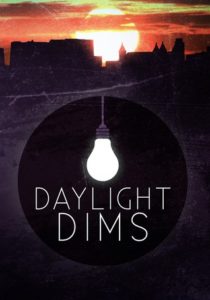
07 Jun The Legend of the Chained Oak
“The Legend of the Chained Oak”
Written by Dan WeathererEdited by Craig Groshek
Thumbnail Art by Craig Groshek
Narrated by N/A
Copyright Statement: Unless explicitly stated, all stories published on CreepypastaStories.com are the property of (and under copyright to) their respective authors, and may not be narrated or performed, adapted to film, television or audio mediums, republished in a print or electronic book, reposted on any other website, blog, or online platform, or otherwise monetized without the express written consent of its author(s).
🎧 Available Audio Adaptations: None Available
⏰ ESTIMATED READING TIME — 9 minutes
I write this piece with a great degree of trepidation, for the knowledge I now pass on to you has resided festering in my mind for many a month. A large proportion of us subscribe to the belief that the past should remain therein. However, I feel the legend of the chained oak needs to be told one last time in its truest form. We owe this to those who suffered genuine horror in its presence.
I first visited the fabled chained oak, located in Oakamoor, Staffordshire, England, after researching a modern version of the legend, told as follows:
One night during a heavy storm, the carriage carrying the 15th Earl of Shrewsbury was stopped by a hooded figure standing in the middle of the forest path which connected Alton Towers to the nearby church of St Giles, situated in the small market town of Cheadle. The figure, illuminated by a streak of lightning, skeletal arm outstretched, begged for a single coin from the Earl. Denied and mocked by the arrogant Earl, the figure removed her hood to reveal her gaunt, grotesque appearance. Enraged, she pointed to an ancient nearby tree and uttered:
“For every branch of the oak that fall,
one of thy family shall perish withal.”
Later that night, the ancient oak is struck by a stray bolt of lightning, severing one of its branches. The next afternoon, the Earl receives word that one of his nieces died from a severe fever that struck without warning in the small hours of the night previous. Stricken by grief and with an undeniable sense of guilt, the Earl orders the oak to be chained, so that no more branches may ever fall, sparing his family the punishment of his selfish ways.
Fast forward five hundred years later and the legend is well told throughout the Staffordshire Moorlands. Set back from a popular walking spot, the oak itself is easy to find. A flight of deeply worn steps leads up to its base, and even in the clearest of daylight the atmosphere surrounding the area is more than a little unnerving. There is an odd stillness to the place, and the sounds of local wildlife cannot be heard. The chains themselves are corroded and marked by the passage of time, and in parts the tree has absorbed the massive rusted links. I have visited the oak many times since uncovering the truths that I will shortly relate, and each visit proves as uncomfortable as the last.
Several months ago, I began to ask around Oakamoor and the surrounding area regarding the popular version of the legend and its credibility. Some of the locals dismissed my interest, and instead spoke of an author they had met who had planned to pen the legend of the oak, promising that his book would provide the locals with an exceptional income; a promise never fulfilled. Others outright refused to discuss the topic. I got the impression that the majority of people I approached were proud of their beautiful village, and had little time or patience for outsiders seeking rumors or idle gossip of years gone by.
Having exhausted several libraries of their resources in my search for scraps of information regarding the chained oak’s origin, I was about to admit defeat in the wake of so few pieces of firm evidence, when during one final visit to a local tavern, I happened upon a man who told me about an intriguing item he had found during the clearing of a cottage located in the village.
He spoke of a tattered journal bound in thick green leather. Apparently it had belonged to one of the older members of the community who had passed away a few weeks previous. The owner’s dying wish was that his home and meager possessions be donated to charity. My generous donator (who wishes to remain anonymous) had decided to keep the journal because of its apparent age and had never gotten past the first page. The book was mine if I so desired.
And so, with the contents of said journal and the morsels of information gleaned from the libraries and records of the time, I present to you the true story of the chained oak.
The Journal
The journal of Joseph Obiah Bedlow, an Oakamoor resident his whole life, was dated as having been written between 1779 and 1804. His age is thirty-two at the time of the diary’s start. Many of his sporadic early entries concern his days working the banks of the river Churnet, logging and replanting trees as per the request of the 15th Earl of Shrewsbury, successful harvest hauls, and scraps of local hearsay amounting to little more than idle gossip. The standout entries begin to appear a third of the way through the journal, beginning on February 3rd, 1783. It is on this date that Mabel Othan, born 1760, according to the census of the period, is first mentioned:
That wretch Mabel of the Othan and her blood, I fear of greatly. Unkempt and forever cursing the villagers, the harshness of winter must fall at her blame. My own eye hath seen her whisper into the shadows. Her company of squalor and vermin be tainting us all.
I believe this excerpt refers to an exceptionally harsh winter which befell the area at the time, and that the villagers’ preliminary grumblings lay the blame on a local recluse named Mabel Othan. While it may seem an unlikely recourse to blame seasonal abnormalities on the actions of a single person, this was a period of great superstition and anyone who acted outside of the accepted norm was treated with a great deal of suspicion.
The next entry is dated February 5th, 1783:
Some of my kin, I will name them not, tasked themselves with the Hand of God and set upon Mabel with thorns and blade. Lest we suffer more hardships ahead.
Upon further research, this entry proved to be important in beginning to understand the basis of the chained oak legend. The entry hints at a process known as “scratching” which, although condemned by the clergy and religious orders of the time, was widely practiced as a cure for witchcraft. The logic behind this gruesome practice was that if one were able to draw blood from the suspected witch’s face, it would release him or her of any evil intent, and the power of the witch would diminish accordingly. Further, applying the blood to the persons or land tainted by the witch’s “magic” would reverse the effects of said spell.
This is also the first entry that confirms the suspicion of witchcraft at work within the community. I assume that the blood of Mabel Othan was obtained for the purpose of cleansing the land that befell the harshness of winter in the hope of more prosperous times to come.
The next entry of significance occurs on 16th March, 1783, and concerns the circumstances regarding the disappearance of a local girl:
The poor Trumble girl, short of her fifth summer, was found face down in the river. A fruitless search the night previous yielded nothing of note. The morning stillness shattered by the cries of a mother in mourning.
Some say that she (Mabel) led the child into the woods, the girl ignoring the pleas of her older sibling to refrain from following. When the village gathered and accused Mabel thus, she remained stoutly silent and absolute. I fear the judgment be already made, for no tears were shed by the guilty. The Earl will need to hear of this.
This entry implies that the tragic death of a local child is suspected to be the work of Mabel Othan. Joseph notes a lack of emotion from the woman and it was strongly believed at the time that practitioners of witchcraft were unable to weep real tears. Mabel’s lack of a reaction seems to have convinced the villagers of her guilt, at least in the eyes of the author. Since the 15th Earl of Shrewsbury is mentioned here, I believe the villagers, inexperienced in dealing with the dark arts and their punishment, felt inclined to turn to a position of authority for guidance.
The next entry of interest occurs on March 18th, 1783:
Curse that book! By following blindly the words of the friars and the will of the Lord, all present shall never forget that night. I have slept little. Even the Earl in his sumptuous quarters will find rest a reluctant bedfellow tonight. May God forgive us.
The book referred to in this entry is believed to be ‘The Malleus Maleficarum’, also known as The Witches Hammer, written by Jacob Sprenger and Henrich Kramer in 1486, both of whom were Dominican Friars. It was widely considered the authoritative text on the persecution of witches.
The next entry is dated several weeks later and discusses at length the events of March 17th, 1783:
It was the belief of the Earl that the cursed daughter be cleansed from this earth. At a late hour, the village led the condemned by torchlight to a large oak betwixt Oakamoor and Alverton. A rope was affixed to the silent Mabel Othan, and one who shall remain nameless began the Verse of Purity used on such occasions. With a nod from the Earl, the stool supporting the wench was kicked aside.
With much kicking and thrashing, and with the creaking and snapping of the oak beam, the silence of that blackest night was shattered. The poor woman fell heavily to the ground, her skeletal leg twisted forwards at a grotesque angle, her face bloodied from the fall. A cry from the bowels of Hell erupted from the throat of her, and the shaken crowd of onlookers backed away, afraid. With eyes of milky white and a mouth of blood came words that shall haunt me to my grave:
“Preserve this tool of merciless death! Let it claim the blood of an innocent on each anniversary of thine evil judgment or, hear me Satan! Thy children are damned!”
I confess all, fearful of what I have seen and heard, and of further horrors of that night now confined in the deepest recesses of my memory. A further rope was found and thrown over a sturdy branch of the Oak.
It took four men of stout heart to lift that shrieking acolyte of Hell from the ground, whom kicked and cursed until she swung deathly still. Her body was hastily buried unmarked, deep into the darkest woodland where no soul was likely to stumble upon her.
It is important to note at this point that the last recorded execution of a witch in England occurred in 1685, and that the last recorded trial of a witch was in 1717.
For a time after, there are no further entries in the leather journal; the events of the night clearly had a profound effect on the writer, and presumably the rest of the village.
The next entry, dated December 16th, 1783, reads:
Have we found good favour with the Lord? For despite our dark deed, the winter is mild and the village content.
Again, the commitment shown by the author to his journal wanes, and it is not until the following February that he commits his next entry to paper:
I am troubled in times of slumber, and I am not alone. My neighbours speak of visions of that fateful night, the cursed words echoing through their nightmares and remaining in waking thoughts. We dare not parse their meaning. The anniversary cometh, yet we must remain resolute in the faith of our fathers.
The entries become increasingly infrequent. A brief note declares that over the following months a number of infants in the village “are born unto the earth cold and still”, and that an unknown fever took the children of the four men who had aided Mabel’s execution:
December 8th, 1784
No physician could advise, and each passed away in turn, youngest to eldest, as foretold that wretched night. An excess of death has afflicted our young. Superstition it may be, but are we to stand idly by and condemn our children to an early burial? I fear damned deeds require further damned deeds before this blight leaves our village in peace.
It seems those that believed the village was cursed set out to locate the unmarked grave with the intent of moving Mabel’s body to the hallowed ground. They relocated her to Oakamoor Parish Cemetery and reburied her on the evening of December 16th, 1784, in the hopes the curse would be abated:
We dug long into the afternoon until the corpse was unearthed. Not a scholar of death myself, I was taken aback by the level of decay, or, should I say, the lack thereof. We wrapped her hurriedly and set for the churchyard.
Upon reading this particular entry, I took it upon myself to search the aforementioned graveyard for the final resting place of the Mabel Othan. Located in a darkened corner of the cemetery is a worn stone lying flat on the ground. Taking a rubbing, I was able to decipher the following words:
Damned by the Ignorant,
Buried by the Repentant,
May Ye Find Peace and Forgiveness.
I believe this stone marks the grave of Mabel Othan.
Referring back to the journal, the next entry occurs June 14th, 1785:
Blessed Earth has not prevailed. The village mourns yet more unborn and little Tom has yet to be found after five days of search. Unspoken that it is, I feel the village knows the course it must take.
The final entry proper occurs on March 17th, 1786:
With finance and blessing from the Earl, the Oak be reinforced with blacksmith chain, lest any limb falls to earth. A boy from Chedle lies bound in a neighbour’s cellar. He shall be the first of our terrible offerings. May our children forgive us, for how could we have known the terrible consequence of our actions?
The remainder of the journal comprises a list of Christian names or vague physical descriptions, each followed by a date. The date and month are always the same, only the year advances, and this continues until 1804, when, according to a note added in a different hand, the writer passed away.
Are the contents of this weathered old journal proof of the truthful origins of the chained oak? To happen across a potential handwritten eyewitness account is good fortune indeed. I have had a small portion of the journal’s paper tested to define its age. The result dates the journal from the late seventeen hundreds.
The possibility of a hoax cannot be overlooked. There is nothing to say that this is not the work of an imaginative soul trying his hand at storytelling. However, I suspect authenticity.
I conclude that the list of names and descriptions at the end of the journal is a record of the persons sacrificed on the chained oak in the belief that the curse affecting the village children be lifted. Up to the present date, there is no further mention in any records of any children from the area dying young or in mysterious circumstances. Could it be that the sacrifices continue even now?
The oak remains chained to this day. Some say the site is a shrine to witchcraft, and that modern-day practitioners are said to visit the tree on certain nights of the year to hold strange vigils in the hope of communicating with the accused witch, Mabel Othan.
Whatever the story behind the chains, I remain convinced the oak still harbors dark secrets that are yet to be revealed.
🎧 Available Audio Adaptations: None Available
Written by Dan Weatherer
Edited by Craig Groshek
Thumbnail Art by Craig Groshek
Narrated by N/A
🔔 More stories from author: Dan Weatherer
Publisher's Notes: N/A
Author's Notes: N/A
More Stories from Author Dan Weatherer:
Related Stories:
You Might Also Enjoy:
Recommended Reading:
Copyright Statement: Unless explicitly stated, all stories published on CreepypastaStories.com are the property of (and under copyright to) their respective authors, and may not be narrated or performed, adapted to film, television or audio mediums, republished in a print or electronic book, reposted on any other website, blog, or online platform, or otherwise monetized without the express written consent of its author(s).








